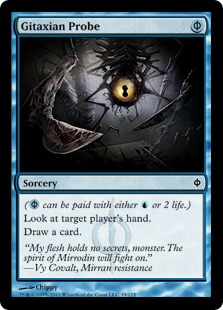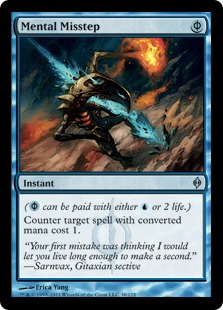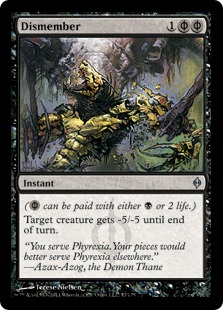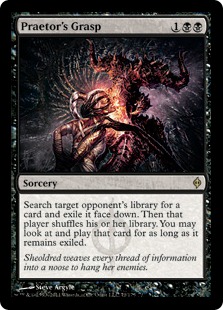With the release of New Phyrexia just a few days away, it seems like a good time to discuss which cards from the latest Magic expansion are likely to
make a big splash in Vintage. In particular, I’ll be focusing on cards that are likely to have an impact in blue control decks and combo decks, while
fellow Vintage expert Andy Probasco investigates
how the new set will impact Mishra’s Workshop decks and creature decks.
People often discuss what it takes for a card to be considered “Vintage Playable,” and certainly when it comes to evaluating new printings,
it is important to have at least a loose understanding of what it takes for a card to make the cut in Vintage.
At least one of the following tends to be true of cards that see play in competitive Vintage decks:
1. The card can provide a unique and powerful effect that cannot be substituted with another card: There are no other cards that do what
Yawgmoth’s Will, Tolarian Academy, or Time Vault do.
2. The card can “do” more than what one might expect for a particular mana cost, which is to say they are cards that are simply
undercosted: Moxen, Black Lotus, Ancestral Recall, Demonic Tutor, Mishra’s Workshop, and Mana Drain are examples of this kind of card.
3. The card can be an efficient way of beating another popular strategy, either as a sideboard card or as a maindeckable tutor target.
These kinds of cards are usually the most mana-efficient ways of generating a particular effect: for example, Nature’s Claim, Hurkyl’s
Recall, Chain of Vapor, Spell Pierce, and Red Elemental Blast are examples of this type of cards.
4. The card creates synergies or redundancies in one’s deck, which is to say it is the glue that holds it all together. These are the
kind of cards that are not necessarily “broken” but are nevertheless very powerful spells that soak up much of the utility in a Vintage
deck and can serve all sorts of different functions depending upon the deck. Examples of this kind of card are Preordain, Dark Confidant, Gush, Thorn
of Amethyst, and Force of Will.
Any particular card, depending upon context, can fit into one or more of these categories—the key is that in order for a card to be viable in
Vintage it must do at least one of these things.
With that being said, let’s move on to the actual New Phyrexia cards.
The vast majority of the playable Vintage cards in NPH revolve around the “Phyrexian Mana” mechanic.
In Vintage, being one step ahead of an opponent, being able to cast one more spell during a counter-war stack, being able to win one turn faster, or
being able to “go off” for one less mana can often make all the difference in the world between having a great deck or having a very
mediocre one.
Two things I have discovered to be consistently true:
1. Playing spells for free is unbelievably great.
2. In Vintage, I would much rather pay for spells or abilities with life than mana.
The speed and efficiency of the cards in Vintage are what make these statements true. Can you imagine if the activated ability on Necropotence cost
“B” instead of “Pay one life?” In general, it would probably be a more powerful card—but in Vintage, it would be much,
much worse. (Sorry, thinking about Necro has gotten me off track… I try to set five minutes aside every day to sit and think about Necropotence
and twenty-five minutes to ponder the mystery that is Time Vault.)
The most important printing in New Phyrexia is:
Gitaxian Probe is going to be a Vintage mainstay for as long as Vintage continues to exist and is going to be a card worthy of consideration in combo
decks from now until the end of time.
The most important thing about this card is that it can be played for free to cantrip—and then played for free again from the graveyard during a
Yawgmoth’s Will turn.
If we ever see another fast and furious Tendrils combo deck like “Long.dec,” I can almost guarantee that it plays four Gitaxian Probes.
While the current predominance of Mishra’s Workshop decks in the metagame probably makes the timing for an
“all-in-can’t-beat-a-sphere” deck pretty poor. However, with Mana Drain decks surging in popularity, it could be the time for a more
controlling Tendrils deck to make a move in the metagame. TPS has traditionally had a strong matchup against blue decks and a weaker (but passable)
Workshop matchup.
With Gitaxian Probe in the format, I’d suggest testing out TPS decks that include the New Phyrexia powerhouse.
Lands (11)
Spells (49)
- 1 Tendrils of Agony
- 1 Brainstorm
- 1 Cabal Ritual
- 1 Yawgmoth's Bargain
- 1 Vampiric Tutor
- 1 Mystical Tutor
- 1 Yawgmoth's Will
- 3 Duress
- 4 Force of Will
- 1 Necropotence
- 1 Mana Vault
- 1 Sol Ring
- 1 Demonic Tutor
- 2 Hurkyl's Recall
- 2 Island
- 1 Time Walk
- 4 Dark Ritual
- 1 Ancestral Recall
- 1 Imperial Seal
- 1 Mana Crypt
- 1 Timetwister
- 1 Gifts Ungiven
- 1 Mind's Desire
- 1 Memory Jar
- 1 Chain of Vapor
- 1 Tinker
- 1 Black Lotus
- 1 Lotus Petal
- 1 Mox Emerald
- 1 Mox Jet
- 1 Mox Pearl
- 1 Mox Ruby
- 1 Mox Sapphire
- 2 Preordain
- 1 Blightsteel Colossus
- 3 Gitaxian Probe

Another cool trick that Gitaxian Probe offers a combo mage is the ability to play a topdeck tutor, such as Mystical Tutor and then draw the card from
the top of the deck without paying mana by using Probe’s alternate Phyrexian life cost. It also adds to the blue card count in the deck, which
helps out immensely with having cards to pitch to Force of Will.
Also, Phyrexian mana spells such as Probe work interestingly against Trinisphere—if you pay the alternate cost of two life, then you only need to
pay two mana to cast the Probe with a 3ball in play.
Probe is also probably playable in Vintage Dredge decks; unfortunately, I don’t care about Dredge decks, I don’t build Dredge decks, I
don’t like Dredge decks, and I am not interested in Dredge decks, so you’ll have to ask somebody else for a list. I will however tell you a
secret: four Leylines of the Void, two Nihil Spellbombs, and one Yixlid Jailer after sideboard has been good enough for me to beat Dredge every single
post-sideboard game I’ve played against it in the past year…
Gitaxian Probe is the one card in the set that I believe has a significant chance of being a Vintage “game changer” that could potentially
redefine an archetype over the course of the next year—however, while New Phyrexia may not provide Vintage with a new slew of format-defining
staples, it does offer a lot of sideboard and utility options.
In particular, the Phyrexian mana cards make up a majority of the playable Vintage cards in the set—simply because they can be paid with life
rather than mana; thus, they will tend to be the most mana-efficient versions of spells that provide a particular effect.
Everybody is going buns wild about how Mental Misstep is going to completely redefine Legacy—however, I haven’t really heard anybody
talking about its application in Vintage. While I believe it is a stretch to play this card in the maindeck, since the entire Mishra’s archetype
rarely even has 1CC spells in their deck, I think it’s possible that Mental Misstep could be a really nice sideboard card in blue-spell decks against
other blue-spell decks.
One thing that I really like about Misstep is that if we’re boarding it in a blue mirror, it’s likely that our opponent will be bringing in Red
Elemental Blasts or Pyroblasts, which, as always, have been a solid tempo play in the past. What gains more tempo than Pyroblasting a blue spell?
Mental Misstep on Pyroblast.
In the same vein as countering REB, Misstep is also good in situations where one taps out to play Jace, the Mind Sculptor, only to have it met by a
Spell Pierce. Before, one would need to use two cards to back it up with Force of Will—now we can simply tap out for Gifts, Jace, or Tinker
without fear of Spell Pierce.
I really like Dismember as a quality Vintage-power-level creature removal spell. In the past, I’ve really liked playing two Doom Blades in my
sideboard, but I’m pretty sure that I’m going to move to one Doom Blade and one Dismember in the future. The ability to essentially pay one mana for a
removal spell that should probably cost two is awesome.
The fact that Dismember costs one mana to play but doesn’t get countered by Chalice of the Void for one is also nontrivial. I also like the fact
that it’s a viable card in many matchups out of a control deck sideboard; unlike Doom Blade, we can be comfortable bringing it in against Dark
Confidant blue decks.
Another nontrivial fact about Dismember: You can Dismember Blightsteel Colossus to give it -5/-5 in order to not get poisoned to death, essentially
buying yourself another turn to try and win. Or, in Christmas land, if two Blightsteel Colossi are fighting in combat, we can shrink our
opponent’s BSC so that ours lives! WOW.
Did you ever want to play Extirpate for free? Now you can.
Surgical Extraction seems better against Dredge decks but worse against control decks than its split second counterpart. Something to think
about—at least now we have options—and apparently more things to play around while our opponents are completely tapped out!
Gremlin Mine: Here is a card that I have not heard people talking about too much that I think could potentially be a solid Vintage sideboard card in
the right deck.
Specifically, I think this card is really interesting as a card that Vintage Control variants with Goblin Welder might really like against MUD decks.
For starters, Welder can bring it back over and over again.
Secondly, it kills pretty much everything in their deck (besides Hellkite) but importantly doesn’t cost more mana with an opposing Lodestone
Golem in play!
The other important interaction is that if you can slip a Gremlin Mine into play early, you can rest a little bit easier if you don’t have a FOW
in hand to stop a Chalice of the Void for one. Yes, Chalice of the Void uses charge counters!
Last but not least: Praetor’s Grasp seems like a pretty amazing card in a combo or control mirror match. Assuming that we’re playing against an
opponent who is also trying to do “blue stuff,” Praetor’s Grasp is a three-mana Demonic Tutor that also deprives an opponent of a key
spell in their deck!
In the Tendrils mirror, we might get their Yawgmoth’s Will, or in a control mirror, stealing an opponent’s Time Vault could be devastating.
One thing to remember is that if you get their Black Lotus or Ancestral Recall and play them, the cards will go to the opponent’s graveyard once
used; so they’ll be able to replay these powerful spells with Yawgmoth’s Will.
All and all, New Phyrexia seems like a really exciting set that should have far-reaching effects on Vintage in the months to come. It remains to be
seen whether or not Gitaxian Probe will turn out to be the card that “Brings Tendrils Back” or whether it will merely be a blip on the
radar. Personally, the card looks amazing, and I’m predicting the former.
New Phyrexia also offers solid utility options for deckbuilders, especially with regard to sideboard cards. I expect cards like Surgical Extraction,
Mental Misstep, and Dismember to see play throughout Vintage in the upcoming months leading up to Gen Con.
I hope you enjoyed the article, and good luck breaking Gitaxian Probe and the rest of New Phyrexia!
Cheers,
Brian DeMars






